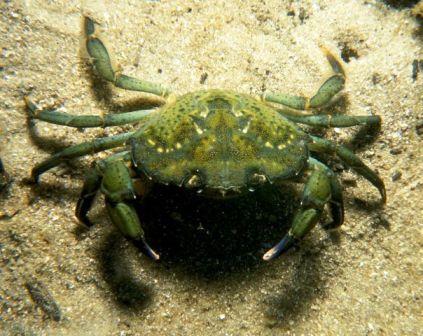
The Green Crab September 3, 2010 The green crab, Carcinus maenas, is a common littoral (of or along the shore) crab and an invasive species, listed among the 100 “world’s worst alien invasive species.” It is native to the north-east Atlantic Ocean and Baltic Sea, but has colonized similar habitats in Australia, South America, South Arica and both the Atlantic and Pacific coasts of North America.
 Courtesy photo
Courtesy photo
The green crab as shown here, is an invasive species.
Its carapace can grow to ninety millimeters (3.5 inches wide). It is felt that the massive dispersion of the species is via a variety of mechanism such as through ships hulls, bivalves moved for aquaculture, and rafting like flotsam.
Carcinus maenas is known by different names throughout the world. In the British Isles, it is referred to simply as the shore crab. In North America and South Africa it is called the green crab or European shore crab. In Australia and New Zealand it is referred to as the European green crab or European shore crab. The carapace of the green crab can grow to sixty millimeters long and ninety millimeters wide with five short teeth along the rim behind each eye. Further they have three undulations between the eyes.
The undulations, which protrude beyond the eyes, are the simplest means of distinguishing C. maenas from the closely-related C. aestuarii, which also can be an invasive species. C. aestuarii lacks any bumps and extends forward beyond the eyes. Another characteristic for distinguishing the two species is the form of the first and second pleopods (part of the thorax of a decapod) , which are collectively known as gonopods and which are straight and parallel in C. aestuarii but curve outwards in C. maenas.
The color of C. maenas greatly varies from green to brown, red, or gray. This variation has a genetic component, but it is largely due to environmental factors locally. In particular, individuals which delay molting become red-colored rather than green and are stronger and more aggressive but are less tolerant of environmental stresses such as low salinity or hypoxia. C. maenas was first observed on the east coast of North America in Massachusetts in 1817, and may now be found from northern Virginia northwards.
By 2007, the species had extended its range northwards to Placentia Bay, Newfoundland.
In 1989, the species was found in San Francisco Bay, California. Until 1993, it was not able to extend its range, but reached Oregon in 1997, the state of Washington in 1998, and British Columbia in 1999 thus extending its range 470 miles in ten years. C. maenas had extended to South America with specimens discovered in Patagonia. C. maenas was first reported in Australia in the late 1800’s in Port Phillip Bay in Victoria.
Since then, it has spread along the south-eastern and south-western seaboards, reaching New South Wales in 1971, South Australia in 1976, and Tasmania in 1993. One specimen was found in Western Australia in 1965 but there have been no discoveries in the area since then. C. maenas first reached South Africa in 1983 in the Table Docks area near Cape Town. And since then, it has spread at least as far as Saldanha Bay in the north and Camps bay in the south over sixty-two miles apart.
There have been appearances of C. maenas recorded in Brazil, Hawaii, the Red Sea, Madagascar, Sri Lanka, Pakistan, and Myanmar; however, these appearances have not resulted in invasions but remain isolated findings. Japan has been invaded by a related crab, either C. aestuarii or a hybrid of C. maenas and C. aestuarii.
Based on the ecological conditions, it is believed that C. maenas could eventually extend its range to colonize the Pacific coast of North America from Baja Calif., to Alaska.
Similar ecological conditions are to be found on many of the world's coasts, with the only large potential area not to have been invaded yet being New Zealand; the New Zealand government has taken action, including the release of a Marine Pest Guide in an effort to prevent colonization by C. maenas.
The Green Crab can live in all types of protective and semi-protected marine and estuarine habitats, including habitats with mud sand, or rock substrates, submerged aquatic vegetation and emergent marsh although soft bottoms are preferred. C. maenas is euryhaline and thus can tolerate a wide range of salinities from four to fifty-two percent and can survive temperatures from thirty-two to eighty-six degrees Fahrenheit. The wide salinity range allows C. maenas to survive in the lower salinities of estuaries.
A molecular biological study using the COI gene found genetic differentiation in the crabs found in the North Sea and those found in the Bay of Biscay; and even more strongly between the populations of Iceland and the Faroe Islands and those elsewhere. This suggests that C. maenas is unable to cross deeper water.
Female green crabs produce up to 185,000 eggs and larvae develop offshore in several stages before their final molt to juvenile crabs in the intertidal zone. Young crabs live amongst seaweeds and sea grasses until they reach adulthood. Then green crab feeds upon a variety of mollusks, worms and small crustaceans, potentially impacting a several fisheries; for example, Argopecten irradians is a scallop which has been impacted by the introduction of Carcinus maenas.
The green crab is a predator feeding on many organisms, particularly bivalve mollusks (such as clams, oysters, and mussels), polychaetes, and small crustaceans. They are primarily nocturnal, although activity also depends upon the tide, and crabs can be active at any time of the day. In California preferential predation by C. maenas on native clams resulted in the decline of the native clams and an increase of a previously introduced clam called the amethyst gem clam.
The green crab has been implicated in the destruction of the soft shell clam, Mya arenan, fisheries on the east coast of the United States and Canada, and the reduction of populations of other commercially important such as scallops and northern quahogs.
The prey of C. maenas includes he young of bivalves as well as fish, although the effect of its predation on winter flounder is minimal. However, C. maenas can have substantial negative impacts on local commercial and recreational fisheries, by preying upon the young of oysters, and the Dungeness crab or competing with them for natural resources. Cancer productus limits the spread of C. maenas in North America.
Due to its potentially harmful effects on ecosystems, C. maenas various efforts have been made to control introduced populations of C. maenas around the world. In Edgartown, Massachusetts, a bounty was established in 1995 for catching C. maenas in order to protect local shellfish and ten tons were caught. There is evidence that the native eastern North American blue crab, Callinectes sapidus, is able to control populations of C. maenas, because C. maenas is not found in Chesapeake Bay, where the native blue crab is most frequent.
On the west coast of North America, C. maenas appears to be limited to upper estuarine habitats in part by predation by native rock crabs (Romaleon antennarium and Cancer productus) and competition for shelter with a native shore crab, Host specificity testing has recently been conducted on Sacculina carcini, a parasitic barnacle, as a potential biological control agent of C. maenas.
In the laboratory, Sacculina settled on, infected, and killed native California crabs, including the Dungeness crab, Metacarcinus magister and the shore crabs Hemigrapsus nudus, Hemigrapsus oregonensis and Pachygrapsus crassipes. Dungeness crabs were the most vulnerable of the tested native species to settlement and infection by the parasite. Although Sacculina did not mature in any of the native crabs, developing reproductive sacs were observed inside a few Metacarcinus magister and Hemigrapsus oregonensis.
Any potential benefits of using Sacculina to control C. maenas on the west coast of North America would need to be weighed against these potential non-target impacts. C. maenas is fished on a small scale in the north-east Atlantic Ocean, with approximately 1200 tons being caught annually, mostly in France and the United Kingdom. In the north-west Atlantic, C. maenas was the subject of fishery in the 1960s, and again since 1996, with up to 86 tons being caught annually.
Fishing report: Hurricanes churn surf; sharks active
The past week two hurricanes have made the waves quite strong and sloppy and the water murky. The morning low tide did not help conditions. In the surf, whiting and flounder were the main catches. In and around Ponce Inlet big tarpon following the mullet run have been caught.
Redfish and sharks were quite active and the jack crevalles have been hitting bait pods. In the Halifax River trout have been hitting fiddler crabs cast by dock pilings in the day. Redfish have been feeding near the deeper entrances to the flats along the Intracoastal. Some sheepshead and black drum have also ben boated. In the Tomoka River and basin conditions were quite rough in the basin and fishing was limited to the river.
There was considerable good tarpon action and they were hitting small baits. Water clarity has diminished. In Mosquito Lagoon & Indian River there gave ben reports of redfish and trout being caught in the early morning and late afternoon. Offshore Hurricane Earl passing by offshore produced 8-12 foot seas and 19 foot seas at the 120 mile offshore buoy.
No sign of Florida red tide locally
Karenia brevis, the Florida red tide organism, was not detected in water samples collected this week in the Indian River Lagoon (Volusia and Brevard counties) or alongshore of Indian River County. K. brevis, was not detected in water samples collected this week alongshore of Franklin County.
An additional sample collected late last week offshore of Escambia County also contained no K. brevis. The Florida red tide organism, was not detected in water samples collected this week alongshore between Pinellas and Collier counties or offshore of Pinellas County.
Additional samples collected late last week offshore of the Florida Keys (Monroe County) also contained no K. brevis.
Capt. Budd's Post Script
It has been written ”When the creator made all things, He first made the dishes in the Big Water. “
So whether you charter, ride a head boat, run your own vessel, stay in the river, surf fish, or fish from shore or a bridge, there are fish to be caught. Fishing is not a matter of life or death, it is so much more important than that.
Tight lines, Capt. Budd
